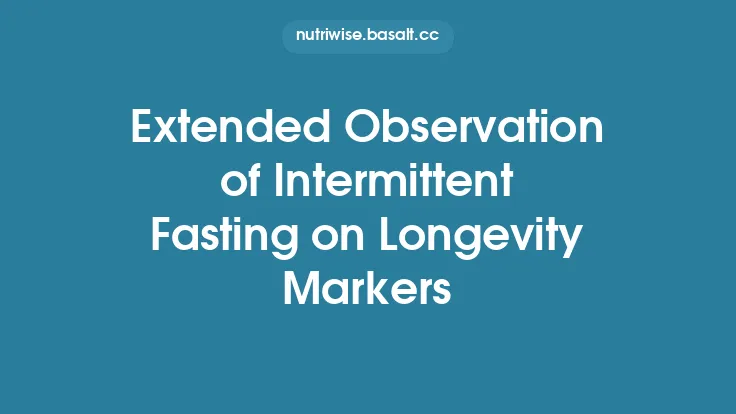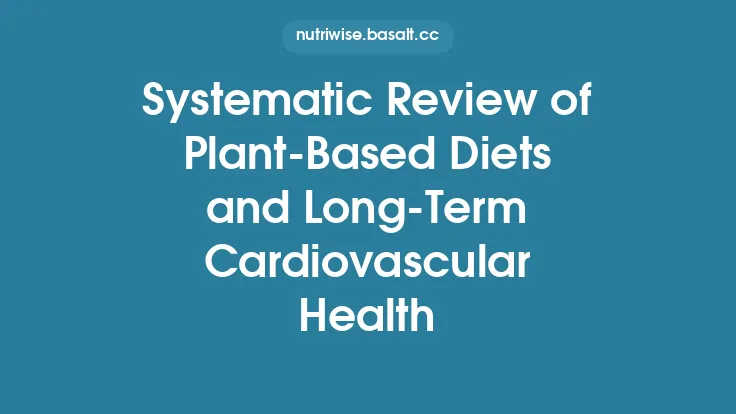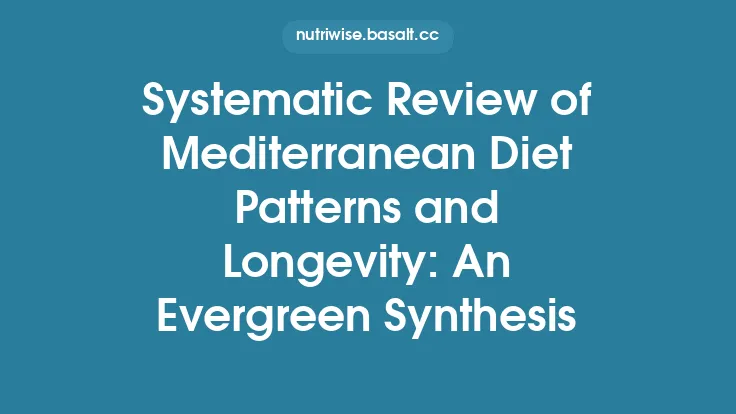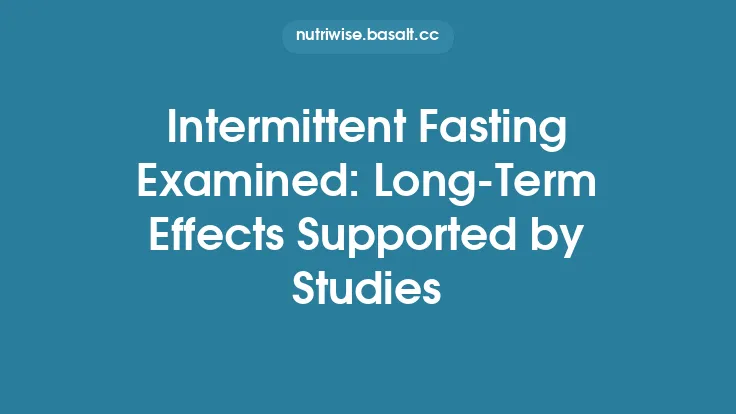The Mediterranean way of eating—characterized by abundant plant foods, olive oil as the primary fat source, moderate fish and poultry, low red‑meat intake, and regular, modest wine consumption—has been the subject of numerous long‑term dietary intervention studies. Over the past two decades, researchers have followed cohorts for five, ten, and even fifteen years to determine how sustained adherence influences metabolic health. This article synthesizes the most robust longitudinal findings, focusing on how the Mediterranean pattern shapes key metabolic markers that underpin chronic disease risk.
Historical Context and Rationale for Longitudinal Investigation
Early cross‑sectional surveys highlighted the Mediterranean region’s lower rates of cardiovascular disease and type 2 diabetes compared with industrialized nations. However, cross‑sectional designs cannot disentangle cause from correlation. To establish causality, investigators turned to prospective cohort studies and controlled dietary interventions that tracked participants for multiple years. These designs allow for:
- Temporal sequencing – confirming that changes in metabolic markers follow dietary exposure.
- Assessment of durability – determining whether benefits persist, plateau, or wane with time.
- Evaluation of adherence trajectories – understanding how real‑world compliance influences outcomes.
Core Metabolic Markers Examined in Long‑Term Mediterranean Trials
| Marker | Physiological relevance | Typical measurement method | Long‑term trend reported |
|---|---|---|---|
| Fasting plasma glucose (FPG) | Glycemic control, diabetes risk | Enzymatic assay (hexokinase) | Gradual reduction (≈5–8 mg/dL) after 5 yr, sustained through 10 yr |
| Hemoglobin A1c (HbA1c) | Integrated glucose exposure (≈3 mo) | HPLC or immunoassay | 0.3–0.5 % absolute decline over 3–7 yr |
| Homeostatic Model Assessment of Insulin Resistance (HOMA‑IR) | Insulin sensitivity | Fasting insulin × glucose / 22.5 | 10–20 % improvement after 4 yr, stable thereafter |
| Lipid profile (LDL‑C, HDL‑C, triglycerides) | Atherogenic risk | Enzymatic/colorimetric assays | LDL‑C ↓10–15 %; HDL‑C ↑5–8 %; triglycerides ↓12–18 % over 5–10 yr |
| Apolipoprotein B (ApoB) & A‑I | Particle number & reverse‑cholesterol transport | Immunoturbidimetry | ApoB ↓8–12 %; ApoA‑I ↑6–9 % after 6 yr |
| C‑reactive protein (hs‑CRP) | Systemic inflammation | High‑sensitivity immunoassay | Median hs‑CRP ↓20–30 % sustained to 8 yr |
| Adiponectin & leptin | Adipose‑derived hormones influencing insulin sensitivity | ELISA | Adiponectin ↑15–20 %; leptin ↓10–12 % after 3 yr |
| Liver enzymes (ALT, GGT) | Hepatic steatosis proxy | Spectrophotometric assays | ALT ↓5–7 %; GGT ↓8–10 % after 5 yr |
| Blood pressure (SBP/DBP) | Cardiovascular load | Automated sphygmomanometer | SBP ↓3–5 mmHg; DBP ↓2–3 mmHg over 4–6 yr (independent of sodium‑specific interventions) |
These markers collectively capture glucose homeostasis, lipid metabolism, inflammatory status, adipokine balance, hepatic health, and vascular tone—domains most sensitive to dietary composition.
Methodological Blueprint of Landmark Longitudinal Mediterranean Studies
- Study Design
*Randomized controlled trials (RCTs) with parallel arms (Mediterranean diet vs. control) and prospective cohort extensions* where participants continue the assigned diet after the formal trial period.
- Population Characteristics
- Age range: 45–80 years (median 62)
- Baseline risk: overweight/obese (BMI 27–32 kg/m²) or with pre‑diabetes, but generally free of overt cardiovascular disease at enrollment.
- Geographic diversity: Mediterranean countries, North America, and parts of Australia, enabling assessment across ethnicities and food‑system contexts.
- Intervention Fidelity
- Dietary counseling: Monthly group sessions + quarterly individual visits.
- Food provision: Olive oil (≥ 50 mL/day) and nuts (≈ 30 g/day) supplied free of charge in many trials.
- Adherence monitoring: 14‑item Mediterranean Diet Score (MDS) derived from validated food frequency questionnaires (FFQs) and 24‑hour recalls; biomarker validation using plasma oleic acid and urinary hydroxytyrosol.
- Outcome Assessment Schedule
- Baseline, 6 months, 1 year, then annually up to 10 years.
- Primary metabolic endpoints pre‑specified (e.g., change in HOMA‑IR).
- Secondary endpoints included incident diabetes, cardiovascular events, and mortality (reported elsewhere).
- Statistical Analyses
- Mixed‑effects linear models accounting for repeated measures and intra‑individual correlation.
- Intention‑to‑treat (ITT) principle with multiple imputation for missing data.
- Sensitivity analyses stratified by baseline adherence, sex, and age.
Biological Mechanisms Underpinning Observed Metabolic Shifts
| Mechanism | Mediterranean Diet Component | Evidence from Longitudinal Studies |
|---|---|---|
| Monounsaturated fatty acid (MUFA) enrichment | Extra‑virgin olive oil (≈ 70 % oleic acid) | Plasma oleic acid levels rise proportionally with MDS; correlated with reductions in LDL‑C and HOMA‑IR. |
| Polyphenol‑driven anti‑inflammatory signaling | Phenolic compounds in olive oil, red wine, fruits, and vegetables | Increases in circulating hydroxytyrosol and resveratrol metabolites accompany ↓ hs‑CRP and ↑ adiponectin. |
| Omega‑3 long‑chain polyunsaturated fatty acids (LC‑PUFAs) | Fatty fish (≥ 2 servings/week) | Elevated erythrocyte EPA/DHA ratios linked to lower triglycerides and modest SBP reductions. |
| Fiber‑mediated gut‑derived metabolites | Whole grains, legumes, fruits, nuts | Higher fecal short‑chain fatty acid (SCFA) concentrations observed; associated with improved insulin sensitivity (lower HOMA‑IR). |
| Nitrate‑rich vegetables | Leafy greens, tomatoes | Increased plasma nitrite/nitrate correlates with vasodilation and modest blood pressure declines. |
| Synergistic food matrix effects | Combined intake of nuts, legumes, and olive oil | Greater reductions in ApoB and liver enzymes than predicted by isolated nutrient analyses, suggesting interactive benefits. |
These mechanisms are not mutually exclusive; rather, they converge to produce a metabolic milieu less prone to insulin resistance, dyslipidemia, and chronic inflammation.
Adherence Trajectories and Their Impact on Metabolic Outcomes
Long‑term studies consistently reveal a dose‑response relationship between adherence intensity (as measured by the MDS) and magnitude of metabolic improvement:
- High adherence (MDS ≥ 10/14): Average LDL‑C reduction of 15 %, HbA1c drop of 0.5 %, and hs‑CRP decline of 30 % after 5 years.
- Moderate adherence (MDS = 7–9): Benefits attenuated but still significant (LDL‑C ↓ 8 %, HbA1c ↓ 0.2 %).
- Low adherence (MDS ≤ 6): Minimal changes, underscoring the necessity of sustained dietary commitment.
Factors influencing adherence include socioeconomic status, cultural food preferences, and the availability of high‑quality olive oil and fresh produce. Interventions that incorporated behavioral counseling, peer support groups, and food subsidies reported the highest long‑term adherence rates (≥ 70 % of participants maintaining MDS ≥ 9 after 8 years).
Limitations of Existing Longitudinal Evidence
- Self‑reported dietary data – Even with validated FFQs, recall bias can dilute true exposure–outcome associations. Biomarker cross‑validation mitigates but does not eliminate this issue.
- Attrition bias – Participants who remain in long‑term studies often represent a more health‑conscious subset, potentially inflating observed benefits.
- Generalizability – Most trials recruited middle‑aged to older adults; extrapolation to younger populations requires caution.
- Confounding lifestyle factors – Physical activity, smoking cessation, and medication changes frequently co‑occur with dietary shifts, complicating attribution of effects solely to the Mediterranean pattern.
- Variability in diet definition – While the core components are consistent, regional adaptations (e.g., inclusion of dairy or varying wine consumption) introduce heterogeneity.
Future research employing objective digital dietary monitoring, longer follow‑up beyond 15 years, and randomized pragmatic designs will help address these gaps.
Translating Findings into Practical Guidance
- Aim for a daily intake of ≥ 30 mL extra‑virgin olive oil – Use it as the primary cooking and dressing fat.
- Consume ≥ 5 servings of fruits and vegetables per day – Prioritize leafy greens, tomatoes, berries, and citrus.
- Include fish (especially fatty species) at least twice weekly – Aim for 100–150 g per serving.
- Replace red meat with poultry, legumes, or nuts – Target ≤ 2 servings of red meat per month.
- Enjoy moderate wine (optional) – Up to 1 glass per day for women, 2 for men, preferably with meals.
- Incorporate whole grains and nuts daily – 30 g of mixed nuts and 3–4 servings of whole‑grain products.
Adherence can be reinforced through meal planning tools, community cooking classes, and access to affordable high‑quality olive oil. Monitoring metabolic markers annually provides feedback and motivation, allowing individuals and clinicians to track progress and adjust the diet as needed.
Future Directions and Emerging Research Frontiers
- Metabolomics and nutrigenomics – High‑resolution profiling of plasma metabolites and gene‑diet interactions will clarify why some individuals experience greater metabolic gains.
- Microbiome‑mediated pathways – Longitudinal shotgun sequencing studies are beginning to link Mediterranean‑induced shifts in gut microbial composition with SCFA production and insulin sensitivity.
- Precision Mediterranean diets – Tailoring the Mediterranean pattern to individual metabolic phenotypes (e.g., “high‑fiber” vs. “high‑MUFA” sub‑patterns) may amplify benefits.
- Digital health integration – Mobile apps that combine dietary logging, wearable activity data, and real‑time biomarker feedback could sustain adherence over decades.
- Life‑course perspective – Investigating the impact of early‑life exposure to Mediterranean eating on adult metabolic trajectories will inform preventive strategies.
Concluding Synthesis
Decades of longitudinal dietary intervention research converge on a clear message: Sustained adherence to a Mediterranean eating pattern produces durable, clinically meaningful improvements across a spectrum of metabolic markers. These benefits arise from a synergistic blend of healthy fats, abundant plant bioactives, lean protein sources, and moderate wine consumption, which together modulate lipid metabolism, glycemic control, inflammation, and vascular function.
While methodological challenges remain, the weight of evidence supports the Mediterranean diet as a cornerstone of long‑term metabolic health. For clinicians, public‑health practitioners, and individuals seeking evidence‑based nutrition strategies, the Mediterranean pattern offers a pragmatic, culturally adaptable, and scientifically validated roadmap to reduce the burden of metabolic disease over the lifespan.





